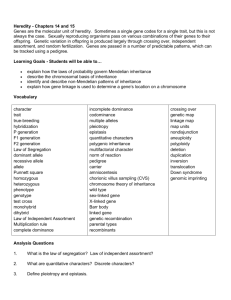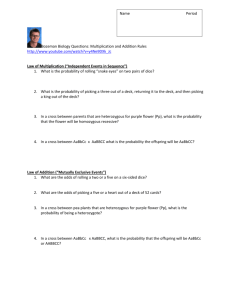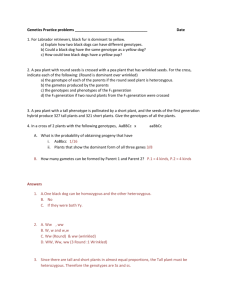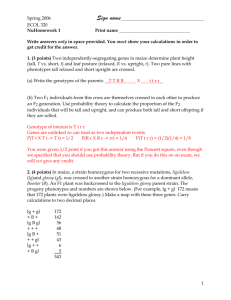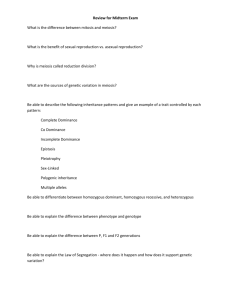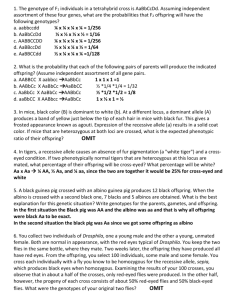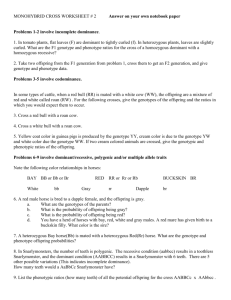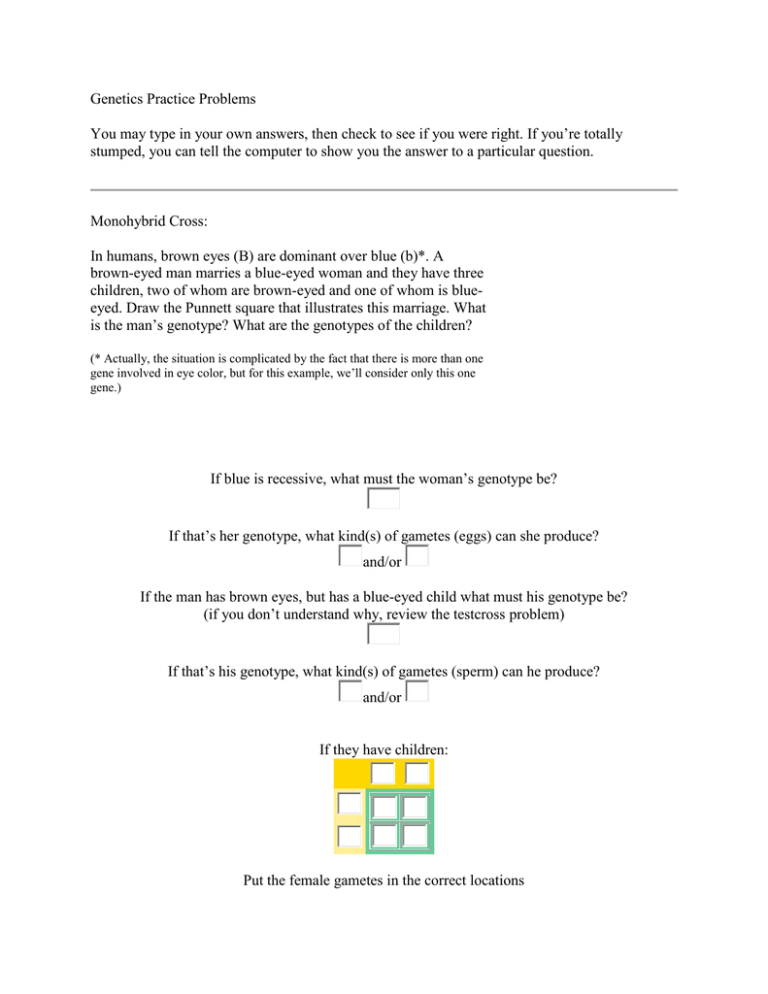
Genetics Practice Problems
You may type in your own answers, then check to see if you were right. If you’re totally
stumped, you can tell the computer to show you the answer to a particular question.
Monohybrid Cross:
In humans, brown eyes (B) are dominant over blue (b)*. A
brown-eyed man marries a blue-eyed woman and they have three
children, two of whom are brown-eyed and one of whom is blueeyed. Draw the Punnett square that illustrates this marriage. What
is the man’s genotype? What are the genotypes of the children?
(* Actually, the situation is complicated by the fact that there is more than one
gene involved in eye color, but for this example, we’ll consider only this one
gene.)
If blue is recessive, what must the woman’s genotype be?
If that’s her genotype, what kind(s) of gametes (eggs) can she produce?
and/or
If the man has brown eyes, but has a blue-eyed child what must his genotype be?
(if you don’t understand why, review the testcross problem)
If that’s his genotype, what kind(s) of gametes (sperm) can he produce?
and/or
If they have children:
Put the female gametes in the correct locations
Put the male gametes in the correct locations
Put the genotypes of the offspring in the correct locations
½ of their children would be expected to be heterozygous brown
and ½ homozygous blue.
Testcross:
In dogs, there is an hereditary deafness caused by a recessive
gene, “d.” A kennel owner has a male dog that she wants to use
for breeding purposes if possible. The dog can hear, so the owner
knows his genotype is either DD or Dd. If the dog’s genotype is
Dd, the owner does not wish to use him for breeding so that the
deafness gene will not be passed on. This can be tested by
breeding the dog to a deaf female (dd). Draw the Punnett squares
to illustrate these two possible crosses. In each case, what
percentage/how many of the offspring would be expected to be
hearing? deaf? How could you tell the genotype of this male dog?
Also, using Punnett square(s), show how two hearing dogs could
produce deaf offspring.
A deaf female is genotype dd. What kind(s) of gametes (eggs) can she produce?
and/or
If the hearing male is DD, what kind(s) of gametes (sperm) can he produce?
and/or
If he is Dd, what kind(s) of gametes can he produce?
and/or
If he is DD:
If he is Dd:
Put the female gametes in the correct locations Put the female gametes in the correct locations
Put the male gametes in the correct locations
Put the male gametes in the correct locations
Put the genotypes of the offspring in
the correct locations
Put the genotypes of the offspring in
the correct locations
All (100%) of offspring can hear
½ of offspring can hear
½ of offspring are deaf
If any of the puppies are deaf, the male is Dd;
but, assuming a litter of at least about 4 to 5 puppies or more, if they can all hear, he is most
likely DD.
If two hearing dogs were both Dd, what kind(s) of gametes (eggs/sperm) could each produce?
and/or
If they are bred with each other:
Put the female gametes in the correct locations
Put the male gametes in the correct locations
Put the genotypes of the offspring in the correct locations
We would expect ¾ of the puppies to be normal and ¼ deaf.
Incomplete Dominance:
Note: at least one textbook I’ve seen also uses this as an example of pleiotropy (one gene – multiple effects), though to my mind,
the malaria part of this is not a direct “effect” of the gene.
For many genes, such as the two mentioned above, the dominant allele codes for the presence of
some characteristic (like, “B” codes for “make brown pigment” in someone’s eyes), and the
recessive allele codes for something along the lines of, “I don’t know how to make that,” (like
“b” codes for the absence of brown pigment in someone’s eyes, so by “default,” the eyes turn out
blue). If someone is a heterozygote (Bb), that person has one set of instructions for “make
brown” and one set of instructions for, “I don’t know how to make brown,” with the result that
the person ends up with brown eyes. There are, however, some genes where both alleles code for
“something.” One classic example is that in many flowering plants such as roses, snapdragons,
and hibiscus, there is a gene for flower color with two alleles: red and white. However, in that
case, white is not merely the absence of red, but that allele actually codes for, “make white
pigment.” Thus the flowers on a plant that is heterozygous have two sets of instructions: “make
red,” and “make white,” with the result that the flowers turn out mid-way in between; they’re
pink.
In humans, there is a gene that controls formation of hemoglobin, the protein in the red blood
cells which carries oxygen to the body tissue. The “normal” allele of this gene codes for
“normal” hemoglobin. However, there is another allele for this gene that has one different
nitrogenous base in its DNA sequence, and thus, one codon in the middle of the gene codes for a
different amino acid in an important place in the hemoglobin molecule. A red blood cell (RBC)
that contains this altered hemoglobin will, under stress, crinkle up into a shape that reminded
someone of the shape of an old-fashioned sickle. While the letters “S” and“s” are often used to
represent these alleles, since both of them code for “make hemoglobin”, in reality, neither is
dominant over the other. Someone who is SS makes all normal hemoglobin, someone who is ss
makes all abnormal hemoglobin (and we say that person has sickle-cell anemia), and someone
who is Ss essentially has two sets of instructions, and so, makes some of each kind of
hemoglobin (often referred to as sickle-cell trait).
Because the RBCs of a person who is ss contain all abnormal hemoglobin, they will “sickle”
very easily, with very little stress required to provoke that reaction. All those sickled cells tend to
get stuck as they try to go through capillaries, and cause things like strokes, heart attacks,
pulmonary embolisms, etc. that lead to death. Because only some of the RBCs of a person who is
Ss contain abnormal hemoglobin, that person usually only has trouble with a lot of cells sickling
if they’re under a lot of stress trying to meet a higher-than-normal oxygen demand, and so the
chances of a person dying from sickle-cell trait are much lower than for full-blown sickle-cell
anemia.
Malaria is a parasitic disease
that’s prevalent in tropical areas.
When a mosquito that’s carrying
the parasites bites someone, the
parasites enter the person’s
bloodstream, and invades and
lives in the person’s RBCs.
However, if a person has sicklecell anemia (ss), the presence of a
parasite in a RBC is so stressful,
it causes the RBC to sickle
A photo, taken by Dr. Fankhauser, of a prepared slide of blood cells infected with
(crinkle up), and when that
Plasmodium vivax
happens, that kills the parasite
before it can multiply and spread to other RBCs. Thus, coincidentally, a person who is ss is also
“immune” to malaria. If a person is Ss and a malaria parasite tries to invade a RBC with
abnormal hemoglobin, again, the RBC will sickle, killing the parasite before it has a chance to
reproduce. If a parasite invades a RBC with normal hemoglobin, it will be able to live and
multiply, but if its offspring invade other RBCs with abnormal hemoglobin, they, too, will be
killed. Thus, a person who is Ss is “resistant” (though not totally immune) to malaria. If a person
is SS and has all normal hemoglobin, the malaria parasites do just fine, invading RBCs, growing
and multiplying, and invading more RBCs. Thus, an SS person usually dies, eventually, from
causes tied to the malaria.
A man and woman living in a tropical area where malaria is prevalent and health care is not
accessible have seven children. The genotypes of these children are ss, Ss, SS, ss, Ss, Ss, and SS.
What must the genotype of both parents be?
(Hint: what would be needed to have those kinds of children?)
If that’s their genotype, what kind(s) of gametes (eggs/sperm) can each produce?
and/or
To figure out what their children would be:
Put the female gametes in the correct locations
Put the male gametes in the correct locations
Put the genotypes of the offspring in the correct locations
¼ of their children would be expected to have normal hemoglobin,
½ should have sickle-cell trait,
and ¼ should have sickle-cell anemia.
Which of their children would you expect to live to adulthood and reproduce?
ss Ss SS ss Ss Ss SS
What is the most likely genotype of the children’s future spouses?
What is the most likely genotype of the surviving grandchildren?
Dihybrid Cross:
In humans, there is a gene that controls formation (or lack thereof) of muscles in the tongue that
allow people with those muscles to roll their tongues, while people who lack those muscles
cannot roll their tongues. The ability to roll one’s tongue is dominant over non-rolling. The
ability to taste certain substances is also genetically controlled. For example, there is a substance
called phenylthiocarbamate (PTC for short), which some people can taste (the dominant trait),
while others cannot (the recessive trait). The biological supply companies actually sell a special
kind of tissue paper impregnated with PTC so students studying genetics can try tasting it to see
if they are tasters or non-tasters. To people who are tasters, the paper tastes very bitter, but to
non-tasters, it just tastes like paper. Let’s let R represent tongue-rolling, r represent a non-roller,
T represent ability to taste PTC, and t represent non-tasting.
Suppose a woman who is both a homozygous tongue-roller and a non-PTC-taster marries a man
who is a heterozygous tongue-roller and is a PTC taster, and they have three children: a
homozygous tongue-roller who is also a PTC taster, a heterozygous tongue-roller who is also a
taster, and a heterozygous tongue-roller who is a non-taster. If these parents would have a bunch
more children so that they had 12 in all, how many of those 12 would you expect to be nontasters who are homozygous for tongue-rolling? If the first child (the homozygous tongue-roller
who is also a PTC taster) marries someone who is heterozygous for both traits, draw the Punnett
square that predicts what their children will be.
If the man is both Rr and Tt (How do we know that?), he would be RrTt and so could produce
gametes with either R or r and either T or t (one allele for each gene). There are two choices for
the first trait (R or r). No matter which of those go into a given sperm, there are still two choices
for the second trait (T or t). Therefore, a total of 2 × 2 = 4 possible types of gametes (sperm) may
be produced. What kind(s) of gametes (sperm) can he produce?
and/or
and/or
and/or
The woman would be RRtt (How do we know that?). What kind(s) of gametes (eggs) can she
produce?
and/or
and/or
and/or
We could put four rows of female gametes, but to simplify things,
since they’re all the same, we can get by with one row.
*
*
*
Put the female gametes in the correct locations
Put the male gametes in the correct locations
Put the genotypes of the offspring in the correct locations
Those marked with an asterisk (*) are the children mentioned in the problem.
¼ of the children (3 out of 12) would be expected to be RRtt (homozygous tongue-rollers who
are non-tasters).
What kind(s) of gametes (let’s say this is a daughter so the gametes are eggs) can their first child
(the homozygous tongue-roller who is also a PTC taster) produce?
and/or
and/or
and/or
The child’s spouse who is heterozygous for both traits would be RrTt like the father. What
kind(s) of gametes (these would, then, be sperm) can the child’s spouse produce?
and/or
and/or
and/or
If they have children:
Put the female gametes in the correct locations
Put the male gametes in the correct locations
Put the genotypes of the offspring in the correct locations
Notice that the children will be ½ homozygous tongue-rollers, ½ heterozygous tongue-rollers;
¾ of the children will be PTC tasters and ¼ non-tasters;
¾ of the homozygous tongue-rollers will be PTC tasters and ¼ non-tasters;
¾ of the heterozygous tongue-rollers will be PTC tasters and ¼ non-tasters;
3/8 of the children will be homozygous tongue-rollers who are PTC tasters,
3/8 heterozygous tongue-rollers who are PTC tasters,
1/8 homozygous tongue-rollers who are non-tasters, and
1/8 heterozygous tongue-rollers who are non-tasters.
Multiple Alleles and Codominance:
Some genes have more than two alleles. One of the best-known examples is the gene that is
referred to as the “ABO Blood Group,” which actually has quite a number of alleles. However,
we will discuss/consider only the three most-common of these. This gene codes for the structure
of a certain antigen on the surface of our RBCs. The three alleles we will work with are
symbolized by IA, IB, and i. However, keep in mind that a person can only have two alleles, two
copies of a gene. Thus, the possible genotypes are IAIA, IAi, IBIB, IBi, IAIB, or ii. (Sometimes, you
will see these simplified as AA, AO, BB, BO, AB, and OO, but that does make it harder to
remember that these are all alleles for the same gene.)
The allele, IA, codes for, “make type A antigen,” the allele IB codes for, “make type B antigen,”
and (to simplify things somewhat) the i allele codes for, “I don’t know how to make either A or
B.” Thus, both IAIA and IAi individuals receive instructions to “make type A antigen,” and both
IBIB and IBi individuals receive instructions to “make type B antigen.” Individuals who are IAIB
receive two sets of instructions: “make type A” and “make type B,” so they have both the A and
B forms of that antigen on the surface of their RBCs. People who are ii don’t have any
instructions to make either A or B, so by “default” they make what we refer to as type O
antigens. Since both IA and IB code for “make something” whereas i codes for, “I don’t know
how, therefore, both IA and IB are dominant over i. However, since both IA and IA code for “make
something,” neither of them is dominant over the other. Thus we say that IA and IB are
codominant over i.
Suppose a person with type A blood and a person with type B blood get married. What are the
possible genotypes their children could have?
First, what possible genotypes can a person be if that person has type A blood?
(Hint: to keep the computer happy, use A, B, and O, rather than IA, IB, and i, even though the
latter are more correct.)
and/or
Which of those genotypes would give rise to the wider variety of genotypes in the children that
are produced?
If that’s that person’s genotype, what kind(s) of gametes (eggs/sperm) would that person
produce?
and/or
What possible genotype(s) can a person be if that person has type B blood?
and/or
Which of those genotypes would give rise to the wider variety of genotypes in the children that
are produced?
If that’s that person’s genotype, what kind(s) of gametes (eggs/sperm) would that person
produce?
and/or
If the mother is the type A person and the father is the type B person,
Put the female gametes in the correct locations
Put the male gametes in the correct locations
Put the genotypes of the offspring in the correct locations
¼ of their children would have type A blood,
¼ would have type B blood,
¼ would have type AB blood, and
¼ would have type O blood.
There is another gene that codes for another, different antigen that also occurs on the surface of
our RBCs, and technically, that gene also has multiple alleles. However, most people either have
or do not have one particular allele called the “d” allele. This gene codes for an antigen that is
called “Rh factor” because it was first discovered in Rhesus monkeys. People who have
instructions to “make d antigen” are referred to as Rh+ (the allele is often symbolized by the
letter “R”), while those who have “I don’t know how to make d antigen” instructions are called
Rh– (the allele can be symbolized by “r”). Since this is a totally separate gene than the ABO
blood group, if you’re doing a genetic cross that involves both ABO and Rh, that would be a
dihybrid cross.
Ms. Johnston, Ms. Johnson, and Ms. Johnstone all entered the same hospital and gave birth to
baby girls on the same day, and all three babies were taken to the nursery to receive care, there.
Someone later claimed that the hospital mixed up the babies. As a hospital administrator, it is
your job to make sure that each pair of parents has the correct baby, so you order blood typing to
be done on all the parents and all the babies. Here are the results:
Person
Blood Type Probable
Possible Gametes
(Phenotype) Genotype
(Eggs/Sperm)
+
Ms. Johnston A
Mr. Johnston B+
Ms. Johnson B–
Mr. Johnson
O+
Ms. Johnstone A+
Mr. Johnstone A–
Baby A
Baby B
Baby C
O+
AB–
B–
First, for each parent, think about what possible genotype(s) could give that phenotype. If there’s
more than one possible genotype, then which of the possible genotypes would give the most
variation in terms of possible children? Put that genotype in the appropriate box, above, for each
person.
(Hint #1: remember, this is a dihybrid cross)
(Hint #2: to keep the computer happy, use letters like A, B, O, R, and/or r)
Next, for each parent, if that is his/her genotype, then what possible kinds of gametes can each
produce? Put those in the appropriate boxes, above.
(Hint: not everyone makes four different types of gametes, so there are some extra boxes that
you should leave blank.)
Then, for each pair of parents, do a Punnett square to determine what kinds of children they can
have.
Johnston
Johnson
Johnstone
For each of the three Punnett squares, put the female gametes (eggs) in the correct locations.
For each of the three Punnett squares, put the male gametes (sperm) in the correct locations.
For each of the three Punnett squares, put the genotypes of the offspring in the correct locations.
So, now, who are the parents of which baby?
Baby A Baby B Baby C
O+
AB–
B–
Johnston
Johnson
Johnstone
Trihybrid Cross:
In Guinea pigs, black hair (B) is dominant over white (b), rough coat texture (R) is dominant
over smooth (r), and short hair (S) is dominant over long hair (s). Assuming these genes are on
separate chromosomes, draw the Punnett square for a cross between a homozygous black, rough,
short-haired Guinea pig and a white, smooth, long-haired one. What would the phenotype(s) of
the offspring be? If two of the F1 offspring were crossed, draw the Punnett square for this cross.
Hint: first make a list of the possible gametes, making sure each has exactly one copy of each of
the genes (one allele for each gene). What would the genotype and phenotype ratios be for the
F2 generation?
In the parental generation,
if we arbitrarily let the female parent be BBRRSS, what kind(s) of gametes (eggs) can she
produce?
and/or
and/or
and/or
and/or
and/or
and/or
and/or
If we arbitrarily let the male parent be bbrrss, what kind(s) of gametes (sperm) can he produce?
and/or
and/or
and/or
and/or
and/or
and/or
and/or
Thus, all of the F1 will have the same genotype. What will that be?
What will they look like – what will their phenotype be?
(Hint: to keep the computer happy, use a comma and space to separate multiple words.)
What kind(s) of gametes (eggs/sperm) can they produce?
and/or
and/or
and/or
and/or
and/or
If they are bred with each other:
and/or
and/or
Put the female gametes in the correct locations
Put the male gametes in the correct locations
Put the genotypes of the offspring in the correct locations
genotypes:
phenotypes:
BBRRSS 1 BbRRSS 2 bbRRSS 1
B–R–S– 27
BBRRSs 2 BbRRSs 4 bbRRSs 2
B–R–ss
9
BBRRss 1 BbRRss 2 bbRRss 1
B–rrS–
9
BBRrSS 2 BbRrSS 4 bbRrSS 2
B–rrss
3
BBRrSs 4 BbRrSs 8 bbRrSs 4
bbR–S– 9
BBRrss 2 BbRrss 4 bbRrss 2
bbR–ss
3
BBrrSS 1 BbrrSS 2 bbrrSS 1
bbrrS–
3
BBrrSs 2 BbrrSs 4 bbrrSs 2
bbrrss
1
BBrrss 1 Bbrrss 2 bbrrss 1
To double check, number of squares = 64,
sum of genotypes = 64,
and sum of phenotypes also = 64.
Polygenic Trait:
Some traits, some phenotypes, are controlled by more than one gene. It was mentioned in the
monohybrid cross, above, that technically, human eye color is controlled by at least two genes,
one which codes for brown vs. blue and another which codes for green vs. blue. In the epistasis
crosses, below, you will see other examples of polygenic traits. Human skin color is also a
classic example of a polygenic trait. It is known that at least three or four genes control skin
color, and for each of those genes, dark pigment has incomplete dominance over light (so a
heterozygote would be intermediate — see above). Because we just did a trihybrid cross, let’s
assume three genes here (for simplicity), and to avoid confusion among them, let’s arbitrarily
call them genes A, B, and C. Then, someone who is AABBCC would have very dark skin color
and someone who is aabbcc would have very light skin color. If they would get married and have
children, their children would all be AaBbCc. If two of those people would get married and have
children, the Punnett square would look like this:
ABC
ABc
AbC
Abc
aBC
aBc
abC
abc
ABC AABBCC AABBCc AABbCC AABbCc AaBBCC AaBBCc AaBbCC AaBbCc
ABc AABBCc AABBcc AABbCc AABbcc AaBBCc AaBBcc AaBbCc AaBbcc
AbC AABbCC AABbCc AAbbCC AAbbCc AaBbCC AaBbCc AabbCC AabbCc
Abc AABbCc AABbcc AAbbCc AAbbcc AaBbCc AaBbcc AabbCc Aabbcc
aBC AaBBCC AaBBCc AaBbCC AaBbCc aaBBCC aaBBCc aaBbCC aaBbCc
aBc
AaBBCc AaBBcc AaBbCc AaBbcc aaBBCc aaBBcc aaBbCc aaBbcc
abC AaBbCC AaBbCc AabbCC AabbCc aaBbCC aaBbCc aabbCC aabbCc
abc
AaBbCc
AaBbcc
AabbCc
Aabbcc
aaBbCc
aaBbcc
aabbCc
aabbcc
So, to summarize, as above:
genotypes:
phenotypes:
AABBCC (6 dark) 1
AaBBCC (5 dark) 2
aaBBCC (4 dark) 1
6 dark alleles
AABBCc (5 dark) 2
AaBBCc (4 dark) 4
aaBBCc (3 dark) 2
5 dark alleles
AABBcc (4 dark) 1
AaBBcc (3 dark) 2
aaBBcc (2 dark) 1
4 dark alleles
AABbCC (5 dark) 2
AaBbCC (4 dark) 4
aaBbCC (3 dark) 2
3 dark alleles
AABbCc (4 dark) 4
AaBbCc (3 dark) 8
aaBbCc (2 dark) 4
2 dark alleles
AABbcc (3 dark) 2
AaBbcc (2 dark) 4
aaBbcc (1 dark) 2
1 dark allele
AAbbCC (4 dark) 1
AabbCC (3 dark) 2
aabbCC (2 dark) 1
0 dark alleles
AAbbCc (3 dark) 2
AAbbcc (2 dark) 1
AabbCc (2 dark) 4
Aabbcc (1 dark) 2
aabbCc (1 dark) 2
aabbcc (0 dark) 1
How many of
each phenotype?
Linked Genes:
Normal fruit flies have grayish-yellow bodies, red eyes, and wings that are long-enough to be
able to fly. Some mutant fruit flies have black bodies rather than grayish-yellow, some have
stumpy, vestigial wings that are too short and wrinkled to be able to fly, and some have a
brighter, orangish-red eye color that is called “cinnabar.” By breeding flies, fruit fly researchers
were able to determine that all three of these mutations were recessive and were on the
autosomes.
Fruit fly researchers use a different type of symbolism to represent their genetic crosses. They
use a plus sign (+) to indicate anything that is the “wild” type and a letter (or sometimes two) to
represent a mutant allele (capital if the mutation is a dominant allele, lower case if it’s recessive).
Thus a fruit fly with a homozygous grayish-yellow body would be labeled as “++” for body
color while a black-bodied fly would be “bb” and a heterozygous fly would be “+b”. The
genotype for normal wings would also be symbolized as “++,” while the allele for vestigial
wings is “vg” so a fly that is homozygous recessive for that gene would be “vgvg” and a
heterozygote would be notated as “+vg”. Similarly, normal red eyes would be “++,” cinnabar
eyes would be ”cncn,” and a heterozygote would be “+cn.”
wild-type female
wild-type male
black, vestigial female
black, vestigial male
To simplify things, for now, let’s consider just the b and vg genes. Suppose we had some flies
that were genotype +b+vg (grayish body and long wings, but a carrier for both the black and
vestigal alleles). Let’s do a testcross (= a cross with bbvgvg, remember?) with these
heterozygous flies.
If these genes were on different chromosomes, the Punnett square for this cross would look like
this:
++
+vg
b+
bvg
bvg +b+vg +bvgvg bb+vg bbvgvg
so out of the offspring, we would expect to get ¼ of each of the four types.
If the genes were linked on the same chromosome and one of the fly’s chromosomes contained
the alleles for yellowish body and normal wings while the other chromosome contained the
alleles for black body and crumpled, vestigial wings, the Punnett square for this cross would look
like this:
++
bvg
bvg +b+vg bbvgvg
so out of the offspring, we would expect to get ½ of each of the two types.
Suppose you are a fruit fly researcher who has bred a group of +b+vg females with bbvgvg
males, and now, you have to count all their offspring. How many offspring would you like to
count?
Females:
Males:
Based on your results, what can you conclude? Would you say these genes are linked or not?
What evidence can you cite to support your conclusion? Actually, in real life, the results are not
as simple as this due to something called “crossing-over.” More information on that may be
found on the Linked and Sex-Linked Genes Web page.
Sex-Linked Genes:
In humans, the genes for colorblindness and hemophilia are both located on the X chromosome
with no corresponding gene on the Y. These are both recessive alleles. If a man and a woman,
both with normal vision, marry and have a colorblind son, draw the Punnett square that
illustrates this. If the man dies and the woman remarries to a colorblind man, draw a Punnett
square showing the type(s) of children could be expected from her second marriage. How
many/what percentage of each could be expected?
A man with normal vision is XY. What kind(s) of gametes (sperm) can he produce?
and/or
Any woman with normal vision could be XX or XX'.
Since this woman has a colorblind son (genotype X'Y), she has to be XX' (a carrier).
What kind(s) of gametes (eggs) can she produce?
and/or
Her first marriage would look like:
*
Put the female gametes in the correct locations
Put the male gametes in the correct locations
Put the genotypes of the offspring in the correct locations
The child marked with an asterisk (*) is the son in the problem.
In order to be colorblind, her second husband must be X'Y (like her son).
What kind(s) of gametes (sperm) can he produce?
and/or
Her second marriage would look like:
Put the female gametes in the correct locations
Put the male gametes in the correct locations
Put the genotypes of the offspring in the correct locations
¼ of the children will be normal female carriers, ¼ colorblind females, ¼ normal males, and ¼
colorblind males;
½ of the children will be females and ½ males;
½ of the children will have normal vision and ½ will be colorblind;
½ of the daughters will be carriers and ½ colorblind;
½ of the sons will be normal and ½ colorblind.
Sex (It’s a Phenotype, Not a Chromosome!):
In humans, there’s another X-linked gene that codes for androgen (testosterone) receptors in our
cells. The dominant allele (XA) codes for “make functioning receptors that can correctly receive
and bind onto testosterone,” but there is a recessive allele (Xa) that either codes for “I don’t know
how to make testosterone receptors” or else “make ‘broken’ receptors that can’t receive and bind
onto testosterone.” In humans, there is also a Y-linked gene that codes for “make testes,” and
when present, they, in turn, make testosterone, and the testosterone, in turn, goes to other cells in
the body, and when received by the receptors, triggers other events within those cells. During
embryonic development, one such event is growth and development of male genitalia.
Consider a person who is genotype XAY. Because this person has a Y chromosome including a
normally-functioning gene to make testes, at the appropriate time during embryonic
development, testes will form and will start to secrete testosterone. Because this person also has
the correctly-functioning allele for the androgen (testosterone) receptor gene, those receptors will
form and will begin functioning. As they receive the testosterone made by the testes, this will
stimulate development of male genitalia, and (assuming all other genes are working “normally”),
this baby will be a boy.
Consider a person who is genotype XAXA. Because this person does not have a Y chromosome,
there is no gene to provide instructions to make testes, therefore no big prenatal surge of
testosterone, therefore no stimulus to make male genitalia (in spite of properly-functioning
testosterone receptors), so by “default,” female genitalia develop, and (assuming all other genes
are working “normally”), this baby will be a girl.
If these two people would get married, the Punnett square for their children would look pretty
much like the ones you’ve just done:
XA
Y
XA XAXA XAY
XA XAXA XAY
½ of the children will be females
½ will be males
Consider a person who is genotype XAXa. Because this person does not have a Y chromosome,
there is no gene to provide instructions to make testes, therefore no big prenatal surge of
testosterone, therefore no stimulus to make male genitalia (in spite of properly-functioning
testosterone receptors in most cells), so by “default,” female genitalia develop, and (assuming all
other genes are working “normally”), this baby will also be a girl. However, she is a carrier for
the non-functioning androgen-receptor gene. Because of inactivation of X chromosomes to form
Barr bodies, some of the cells in her body will not be able to receive testosterone messages,
which might show up in things like having somewhat less pubic and/or armpit hair.
If she marries the man mentioned above, what would their children’s genotypes be?
XA
A
X
Xa
Y
Put the genotypes of the offspring in the correct locations
¾ of the children will be females
¼ will be males
No, that’s not a typo! The phenotype ratio is 75:25, not 50:50. There’s a “new” genotype in there
that hasn’t been mentioned, yet: XaY, and the corresponding phenotype is female. Let’s look at
that person’s embryonic development. There is a Y chromosome, and assuming its genes are
functioning normally, testes do develop and begin to secrete testosterone. However, all that
testosterone has nowhere to go; the testosterone receptors don’t work, so as far as everything else
in her body is concerned, its as though all that testosterone isn’t even there. Thus, just exactly
like anyone/everyone else whose body doesn’t get a message/stimulus to make male genitalia, by
“default” female genitalia develop, and (assuming all other genes are working “normally”), this
baby will be a girl. This is called Androgen Insensitivity Syndrome (AIS). See the Sex-Linked
Genes Web page for a more detailed explanation.
Sex-Influenced Traits:
Baldness in humans is a dominant, sex-influenced trait. This gene
is on the autosomes, not the sex chromosomes, but how it is
expressed is influenced by the person’s sex (due to hormones
present, etc.). A man who is BB or Bb will be bald and will be
non-bald only if he is bb. A woman will only be bald if she is BB
and non-bald if she is Bb or bb (it’s almost like B is dominant in
males and b is dominant in females). Actually, because of the
influence of other sex-related factors, most women who are BB
never become totally bald like men do, but rather, their hair
becomes “thin” or sparse. If two parents are heterozygous for
baldness, what are the chances of their children being bald? Use a
Punnett square to illustrate this. Note: because the sex of a person does make a difference in how
the gene is expressed, you need to set this up as a dihybrid cross to account for the sex of the
children.
The woman is XXBb. What kind(s) of gametes (eggs) can she produce?
and/or
and/or
and/or
Her husband would be XYBb. What kind(s) of gametes (sperm) can he produce?
and/or
and/or
and/or
If they have children:
*
*
*
*
Put the female gametes in the correct locations
Put the male gametes in the correct locations
Put the genotypes of the offspring in the correct locations
Those marked with an asterisk (*) will be bald.
1/8 of the children will be bald daughters, 3/8 will be normal daughters,
3/8 will be bald sons, and 1/8 will be normal sons;
½ of the children will be daughters and ½ sons;
½ of the children will be bald and ½ normal;
¼ of the daughters will be bald and ¾ normal;
¾ of the sons will be bald and ¼ normal.
A non-bald man marries a non-bald woman. They have a son and a daughter. If the son becomes
bald, what are the chances that his sister will, too? Use a Punnett square to show this cross.
A non-bald man has to be XYbb. What kind(s) of gametes (sperm) can he produce?
and/or
and/or
and/or
Any non-bald woman can be XXBb or XXbb. The bald son could be XYBB or XYBb, but since
the father is XYbb, we know the son cannot be XYBB (remember the first problem?). The son
has to be XYBb, therefore this mother has to be XXBb (if she was XXbb he couldn't have a B).
What kind(s) of gametes (eggs) can she produce?
and/or
and/or
and/or
If they have children:
*
Put the female gametes in the correct locations
Put the male gametes in the correct locations
Put the genotypes of the offspring in the correct locations
The child marked with an asterisk (*) is the son in the problem.
The daughter could be XXBb or XXbb, in neither case, bald: 0% chance.
A woman’s mother is bald, but her father is not. Her older brother is rapidly going bald. She is an
acrobat who hangs by her hair. Should she change her profession before she goes bald, too? Use
a Punnett square to show this.
If the mother is bald, she has to be XXBB. What kind(s) of gametes (eggs) can she produce?
and/or
and/or
and/or
If the father is not bald, he has to be XYbb. What kind(s) of gametes (sperm) can he produce?
and/or
and/or
and/or
What will the genotype of all their male children (like her brother) be?
What will the genotype of all their female children (like her) be?
Will she go bald? ||
Yes, get a different job. ||
No, keep hanging by her hair. ||
Epistasis:
In sweet peas, purple flower color (P) is dominant over white (p),
but there is also a control gene such that if the plant has a “C”, the
purple has “permission” to express itself. If the plant is “cc,” the
purple does not “have permission” to express itself and the flower
will be white anyway. If a plant with homozygous purple,
controlled flowers is crossed with a plant with white, noncontrolled flowers, diagram the Punnett square for the F1 and F2
generations and calculate the genotype and phenotype ratios.
Because you must keep track of both the purple/white and the control genes, you need to set this
up like a dihybrid cross.
If we arbitrarily let the female parent be PPCC, what kind(s) of gametes (eggs) can she produce?
and/or
and/or
and/or
If we arbitrarily let the male parent be ppcc, what kind(s) of gametes (sperm) can he produce?
and/or
and/or
and/or
Thus, all of the F1 will have the same genotype. What will that be?
What will they look like – what will their phenotype be?
If all of the F1 are PpCc, what kind(s) of gametes (eggs/sperm) can they produce?
and/or
and/or
and/or
The Punnett square for the F2 generation will look like:
Put the female gametes in the correct locations
Put the male gametes in the correct locations
Put the genotypes of the offspring in the correct locations
genotypes:
phenotypes:
PPCC 1
P–C– = purple
9 } 9 purple
PPCc
2
P–cc = white bec. of cc 3
PPcc
1
ppC– = white bec. of pp 3
7 white total
PpCC 2
ppcc = white
1
PpCc
4
Ppcc
2
ppCC 1
}
ppCc
ppcc
2
1
Epistasis can also work in the “opposite” direction (actually, some textbooks give these two
cases other names). In corn kernels, purple (P) is dominant over yellow (p), but there is also an
inhibiting control gene such that if that corn kernel has a “C”, the purple does not “have
permission” to express itself, and the kernel will be yellow. If that kernel is “cc”, then the purple
has “permission” to be expressed. If the same cross as above is done, the result would be:
genotypes:
PPCC
1
PPCc
PPcc
PpCC
PpCc
Ppcc
ppCC
ppCc
ppcc
2
1
2
4
2
1
2
1
phenotypes:
= yellow bec. of
P–C–
9
C–
13 yellow total
ppC– = yellow
3
ppcc = yellow bec. of pp 1
P–cc = purple
3 } 3 purple
}
There are some other, interesting possibilities. Suppose that in corn kernels, purple (P) is
dominant over some other color, say red (p). However, suppose there is a control gene (C) which
“permits” the color to be present and “cc” doesn’t “permit” color to be present, resulting in
yellow kernels. If the same cross as above is done, the result would be:
genotypes:
PPCC 1
PPCc
2
PPcc
1
PpCC 2
PpCc
4
Ppcc
2
ppCC 1
ppCc
2
ppcc
1
phenotypes:
P–C– = purple
9 } 9 purple
P–cc = yellow bec. of cc 3
4 yellow total
ppcc = yellow bec. of cc 1
ppC– = red bec. of pp
3 } 3 red
}
Suppose, instead, that “C” inhibits or does not “permit” the color to be present, while “cc” does
allow the color to be expressed. If the same cross as above is done, the result would be:
genotypes:
PPCC 1
PPCc
2
PPcc
1
PpCC 2
PpCc
4
Ppcc
2
ppCC 1
ppCc
2
ppcc
1
phenotypes:
P–C– = yellow bec. of C– 9
12 yellow total
ppC– = yellow bec. of C– 3
P–cc = purple
3 } 3 purple
ppcc = red bec. of pp
1 } 1 red
}
carterjs@uc.edu
File geneprob.htm was last modified on Tue 22 Jun 2010.
Copyright © 1996 by J. Stein Carter. All rights reserved.
This page has been accessed
times since 14 Mar 2001.

